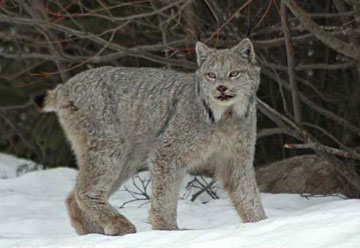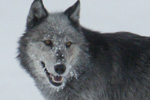In 2000 the Canada lynx (Lynx canadensis) was listed as threatened under the US Endangered Species Act (ESA). While remaining stable in Canada and Alaska, the Canada lynx population had essentially collapsed in much of the continental US, excluding Alaska. Aside from habitat loss, one of the main factors imperiling the medium-sized wild cat was a decline in prey, specifically snowshoe hares (Lepus americanus). Researchers have now come up with an innovative way to aid hungry lynx in the US: wolves.
A new study in Wildlife Society Bulletin argues that wolves could help the recovery of Canada lynx in the US by allowing snowshoe hare populations to bounce back. How would wolves do this? The answer is: by keeping coyotes in check. Researchers believe an explosion in the US coyote range and population, following the decimation of wolves, has led to direct competition between lynx and coyote for snowshoe hares—with coyotes winning by far.
As top predators, wolves play a huge role in the ecosystem: they not only rein-in populations of their prey, such as elk and moose, but also keep a tight leash on ‘mesopredators’. Ecologically speaking, mesopredators are those carnivores beneath the top predator, such as coyotes. While wolves are known to harass and kill coyotes, they also keep them in line through sheer terror.
 Population declines have pushed the Canada lynx (Lynx canadensis) onto the US Endangered Species Act. |
“Before they were largely extirpated, wolves used to kill coyotes and also disrupt their behavior through what we call the ‘ecology of fear,'” William Ripple, a professor in the Department of Forest Ecosystems and Society at OSU, said in a press release. The ‘ecology of fear’ means that coyotes will be far more wary to venture into certain areas if they know wolves are present.
When wolves were killed off throughout the entirety of the lower 48 states, it spawned a ‘mesopredator release’, where lower predators like coyotes begin to run wild. Imagine what would happen to a Junior High school if all the teachers disappeared overnight, and one has a sense of the changes wrought to the US wilderness when wolves were killed off.
“In the absence of wolves, coyote densities and distributions generally expanded in the U.S., into the Midwest, to the northeast as far as Newfoundland, and as far northwest as Alaska,” the researchers wrote in their report. Range not only expanded, but population as well boomed. And this rise of coyote-run ecosystems had a massive impact on lynx, according to the paper.
“Coyotes have a flexible, wide-ranging diet, but they really prefer rabbits and hares, and they may also be killing lynx directly,” Ripple says.
So, one solution to saving the lynx may be supporting current wolf populations, while considering reintroductions of wolves in viable lynx habitat. In fact, the researchers say ‘ecologically effective’ wolf populations should be maintained. Still, wolf-politics has rarely depended on their ecological value, instead bouncing between wolf-lovers and wolf-haters. This year the US Congress stripped wolves in the Northern Rockies of protection by the Endangered Species Act (ESA), opening the door to wolf-hunting. It was the first time any species has been taken off the list by congress.
The last decade-and-a-half has been especially important for understanding the role of top predators in ecosystems in large part due to the reintroduction of wolves in Yellowstone National Park after a 70-year-absence. The return of the top dog, so to speak, provided researchers with a first hand look at how apex predators impact ecosystems through what is known as a ‘trophic cascade’, i.e. impacts down through the foodchain. The findings have been shocking: while wolves are still reviled in many parts of the US, science is showing time and again that these animals are key to a healthy, diverse ecosystem.
Research has found that by keeping elk on the run and in hiding, wolves protect plants and trees that had long been over-browsed, saving some species from local extinction. The presence of wolves allowed trees to grow up along rivers for the first time in decades, protecting against erosion and cooling rivers through shade. In turn, the riverside trees allowed for the return of beavers, which had nearly vanished from Yellowstone. Through dam-building beavers created new habitat for fish. With more trees and shrub cover, songbird populations rose. Scavengers from bear to ravens were aided by wolf-kills. In all, biodiversity and wildlife abundance blossomed.
As to mesopredators, coyote populations were initially cut in half when wolves returned to Yellowstone. While this hurt coyotes, it likely helped some of their favorite prey. In fact, early evidence points to a snowshoe hare recovery, but researchers must collect more data to know for certain. If the hares do recover, the Canada lynx may not be far behind. And the wolf, rather than being the villain of the piece, becomes the unsung hero.
Related articles
Decline in top predators and megafauna ‘humankind’s most pervasive influence on nature’

(07/14/2011) Worldwide wolf populations have dropped around 99 percent from historic populations. Lion populations have fallen from 450,000 to 20,000 in 50 years. Three subspecies of tiger went extinct in the 20th Century. Overfishing and finning has cut some shark populations down by 90 percent in just a few decades. Though humpback whales have rebounded since whaling was banned, they are still far from historic numbers. While some humans have mourned such statistics as an aesthetic loss, scientists now say these declines have a far greater impact on humans than just the vanishing of iconic animals. The almost wholesale destruction of top predators—such as sharks, wolves, and big cats—has drastically altered the world’s ecosystems, according to a new review study in Science. Although researchers have long known that the decline of animals at the top of food chain, including big herbivores and omnivores, affects ecosystems through what is known as ‘trophic cascade’, studies over the past few decades are only beginning to reveal the extent to which these animals maintain healthy environments, preserve biodiversity, and improve nature’s productivity.
(04/17/2011) A ‘rider’ attached to the most recent budget passed this week in the US congress has stripped gray wolves from the protection of the Endangered Species Act, a first in the law’s nearly 40-year-history. The rider, which was signed into law under the budget on Friday by US President Barack Obama, hands gray wolves (Canis lupus) in Montana, Idaho, Utah, Washington, and Oregon from Federal protection to state control. Hunting is expected to begin soon.
Why top predators matter: an in-depth look at new research
(02/02/2010) Few species have faced such vitriolic hatred from humans as the world’s top predators. Considered by many as pests—often as dangerous—they have been gunned down, poisoned, speared, ‘finned’, and decimated across their habitats. Even where large areas of habitat are protected, the one thing that is often missing are top predators. However, new research over the past few decades is showing just how vital these predators are to ecosystems. Biologists have long known that predators control populations of prey animals, but new studies show that they may do much more. From controlling smaller predators to protecting river banks from erosion to providing nutrient hotspots, it appears that top predators are indispensible to a working ecosystem. Top predators sit at the apex of an ecosystem’s food chain. Wolves in Alaska, tigers in Siberia, lions in Kenya, white sharks in the Pacific are all examples of top predators.








